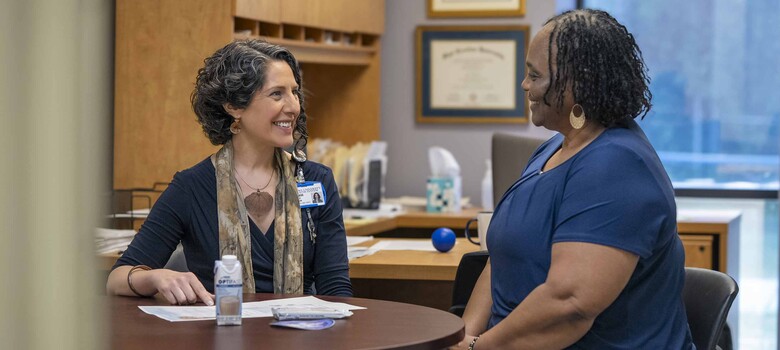 From the DukeHealth.org archives. Content may be out of date.
From the DukeHealth.org archives. Content may be out of date.
New Options for Relieving Hip Pain

The Duke Young Hip Center helps people age 50(ish) and younger find solutions for hip ailments, to prevent the development of severe arthritis in the hip, and to stave off total hip replacement, perhaps permanently. The hip preservation program treats children and adults for cartilage problems, abnormally shaped hip joints, loss of blood supply to the joint, and more.
Whether you’re a salsa dancer or an office manager, your hips are meant to move. The hip joint is constructed to move fluidly in a variety of directions. When a hip doesn’t move well, from pain or another source, it affects your ability to walk, run, sit, and sleep comfortably.
Hip pain isn’t reserved for the elderly. It can strike at any age: young dancers, 20- or 30-something triathletes, or older adults. But we’re tough, we humans. Many of us walk (or shuffle) around with hip pain for years, either because we have a high pain tolerance or because we believe we have no other choice. That’s an unfortunate tendency, says Duke orthopaedic surgeon Steve Olson, MD, because hip pain—like most other pain—is a call to action: it’s your body’s way of asking you to pay attention, to make things better before they get worse.
Dr. Olson leads Duke’s new Young Hip Center, which helps people age 50(ish) and younger find solutions for hip ailments. The hip preservation procedures it offers prevent the development of severe arthritis in the hip, and to stave off total hip replacement, perhaps permanently. The program treats children and adults for cartilage problems, abnormally shaped hip joints, loss of blood supply to the joint, and more.
To Replace or Not to Replace?
Often, what goes wrong in the hip joint is degradation of cartilage—the smooth material that coats the surfaces between the ball and socket in the joint. Years of wear and tear, anatomical anomalies, repetitive stresses, accidents, or other traumas can all cause the cartilage to break down or tear, leading to pain.
If arthritis develops, where the cartilage has worn away to the point that the joint has no cushion left, there is only one current cure: total hip replacement. And if you’re already heading in that direction, why not just go through the surgery and get it over with?
“The truth is, most patients who have total hip replacements do very well,” Dr. Olson said. But there are good reasons to put off the full joint replacement. After the surgery, you’ll always be at a small risk for needing revision surgeries to correct for malfunctions or wear and tear in the new joint. Also, infection becomes a more important issue: internal infections, if they spread to the replaced hip joint, might require surgery to clear up. “That’s why patients with hip replacements need to treat an infection of any kind immediately,” Dr. Olson said.
Especially for younger patients, the change in lifestyle can be the most difficult adjustment. “After you have a hip replacement, high-impact sports are not recommended,” Dr. Olson said. “We see a lot of people in their 40s and 50s who are parents of young children. They want to stay active, to chase after their kids, and that makes surgery a tough option.”
When Hip Preservation Surgery Becomes an Option
The strategy many doctors follow regarding hip replacement is to wait—to help patients negotiate that fine line of tolerating their symptoms for as long as possible, but not so long that they lose function or develop other problems. Doctors at the Duke Young Hip Center also specialize in several less invasive procedures that may make hip replacement unnecessary. “As we’ve learned more about what causes hip pain, we’ve been able to refine the treatment strategies,” Dr. Olson said. “We now know that each of us is as unique on the inside as we are on the outside,” and subtle differences in a person’s basic anatomy can put them at greater risk for certain problems. Many of these problems can be addressed early on, before arthritis or profound loss of function develops.
Duke’s Young Hip Center brings together a team of surgeons, physician assistants, and nurses, and a variety of diagnostic tools, numbing injections that can help tease out the source of the pain, and special imaging studies that illuminate the cartilage in the joint space. “Most people who come to see us have already seen three or four other doctors first,” Dr. Olson said, so the team works to triage patients to the most effective specialist for their condition, as quickly as possible.
Based on the underlying problem, a doctor recommends a course of action: often patients may start with nonoperative treatments, such as steroid injections and physical therapy. If surgery is necessary, patient and surgeon work together to craft a treatment plan that matches the patient’s lifestyle. “It’s always a very personalized plan of action with each of our patients, based on their symptoms, their lifestyle, and their goals,” Dr. Olson said, “and we’re learning more and more about who really benefits from one treatment versus another. The idea behind all these procedures is to prevent hip arthritis. Although some people might still get arthritis, we believe taking action early can prevent a lot of pain—and bigger surgeries—later on.”
Surgical Options
Surgical strategies today can repair cartilage, trim bones, or in other ways make a hip joint more mobile or stable. The Duke Young Hip Center offers several options, including:
- Arthroscopy. A minimally invasive procedure to repair torn cartilage, trim the bone in the ball or the socket, or otherwise make minor adjustments or repairs to the structures in the joint space.
- Periacetabular osteotomy. Many patients who have hip dysplasia find relief from this surgery, in which the socket is repositioned in the pelvis to provide more stability to the joint.
- Surgical dislocation. In this procedure surgeons dislocate the ball from the socket, make any needed revisions to the joint surfaces, and put the joint back together. This procedure is especially useful in children who have anatomical anomalies that lead to dislocation in the joint.
- Free vascularized fibular grafting. In this procedure developed at Duke by James Urbaniak, MD, the dead bone is removed and replaced with healthy bone from the fibula in a way that provides a new source of blood flow, preserving the hip.
- Hip resurfacing. In this alternative to total hip replacement, a metal cap is placed over the femur and a metal cup is placed over the socket. This is an excellent alternative for patients whose arthritis is too advanced for other forms of joint preservation.


